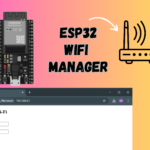Index
GPIO = General Purpose Input/Output
These are the digital pins on the ESP32 that you can use to:
- Control devices like LEDs, buzzers (output)
- Read devices like buttons, sensors (input)
Step 1: Set up your Environment
Make sure you:
- Have MicroPython firmware flashed on your ESP32
- Are using Thonny IDE (or any MicroPython editor)
- Board is connected and showing up in Thonny
Step 2: Import Required Module
To control GPIO, you need to use the machine module:
from machine import Pin
Step 3: Blink an LED (Output)
Connect an LED to GPIO (e.g., Pin 2 with a resistor)
from machine import Pin
import time
led = Pin(2, Pin.OUT) # Set GPIO2 as output
while True:
led.on() # LED ON
time.sleep(1) # Wait 1 second
led.off() # LED OFF
time.sleep(1)
Explanation:
Pin(2, Pin.OUT)→ Use GPIO 2 as outputled.on()→ Sets pin HIGH (3.3V)led.off()→ Sets pin LOW (0V)
Step 4: Read a Button (Input)
Connect a push button to GPIO14 (with pull-down resistor)
button = Pin(14, Pin.IN) # Set GPIO14 as input
while True:
if button.value() == 1:
print("Button Pressed")
else:
print("Button Released")
time.sleep(0.5)
Explanation:
Pin(14, Pin.IN)→ GPIO14 is input pinbutton.value()→ Reads pin (0 or 1)
⚠️ If using no external resistor, you can enable internal pull-up:
button = Pin(14, Pin.IN, Pin.PULL_UP)
Step 5: Combine Button and LED
LED lights up when button is pressed
led = Pin(2, Pin.OUT)
button = Pin(14, Pin.IN, Pin.PULL_UP) # active LOW
while True:
if button.value() == 0: # Button pressed
led.on()
else:
led.off()
time.sleep(0.1)
Step 6: Try This Challenge
Task: Blink LED 5 times when the button is pressed.
led = Pin(2, Pin.OUT)
button = Pin(14, Pin.IN, Pin.PULL_UP)
while True:
if button.value() == 0:
for i in range(5):
led.on()
time.sleep(0.3)
led.off()
time.sleep(0.3)
Summary
| Mode | Code Example | Purpose |
|---|---|---|
| Output | Pin(2, Pin.OUT) | Control LED, buzzer |
| Input | Pin(14, Pin.IN) | Read button/sensor |
| Pull-up | Pin(14, Pin.IN, Pin.PULL_UP) | Input with internal resistor |
| Read value | pin.value() | 0 or 1 |
| Set value | pin.on(), pin.off(), pin.value(1) | HIGH or LOW |


